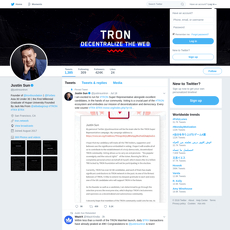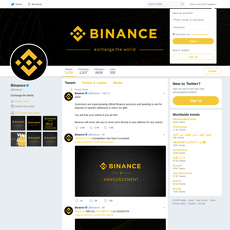Brian Armstrong Review
Brian Armstrong
twitter.com
Brian Armstrong (@brian_armstrong) review guide: everything you need to know + FAQ
Is following Brian Armstrong on X/Twitter actually worth your time, or just another notification that steals your focus?
If you care about crypto policy, mainstream adoption, and where the next real shift might come from, his feed can be a signal in a lot of noise. But only if you read it the right way.
I’ve watched how CEO posts sway sentiment and sometimes markets. This isn’t theory—there’s solid evidence that leader-driven social chatter can move prices and attention. Bitcoin’s sharp reactions to influencer tweets are well documented by the press (CNBC, Reuters), and researchers have shown how social signals correlate with crypto booms and busts (Royal Society Interface). So when a founder-CEO with Coinbase’s reach posts about policy, Bitcoin, or infrastructure, it’s worth paying attention—but not blindly reacting.
What you’ll typically see from Brian’s account: calls for clear crypto rules, thoughts on U.S. competitiveness, long-term Bitcoin views, and updates tied to Coinbase products and industry infrastructure.
In this guide, I break down what you’ll really get from Brian’s posts, how to read them like a pro, where his biases show up, and how I use his feed to spot trends early. The goal is simple: follow smarter, not just scroll faster.
The problems most people face when following big crypto voices
Let’s be honest: it’s easy to get whiplash on Crypto Twitter. Here’s why:
- Too many takes, not enough context. Big accounts react quickly to headlines. Without framing, you can mistake commentary for confirmed news.
- Incentives matter. Brian is a builder, investor, and policy advocate. His posts can reflect Coinbase’s strategy while also nudging the industry. Both can be true.
- Market sensitivity. High-profile posts can spark crowd reactions—sometimes out of proportion to the underlying facts. Studies and real-world events show social signals can amplify volatility.
- Marketing vs signal. Product news, policy advocacy, and personal opinions often live in the same thread. If you don’t separate them, you’ll miss what’s actionable.
- Echo chambers. If your feed leans one way, you’ll only see confirmation. That’s deadly for decision-making.
Real-world example of the problem: during major policy pushes (like debates over crypto legislation in the U.S.), you’ll see posts urging action, posts interpreting legal moves, and posts celebrating progress—all within hours. If you treat the whole stream as a trade signal, you’ll get chopped up. If you tag and track the parts (advocacy vs. hard updates), you’ll actually learn something.
What I’ll help you do (promise)
- Spot what Brian posts about most and when it matters.
- Tell the difference between opinion threads and hard updates you can verify.
- Use his feed for investor signals (medium-term), builder insights (infra and standards), and policy tracking (what could unlock or slow adoption).
- Get a quick FAQ so you can answer the most common questions without scrolling for an hour.
I’ll also show you a simple system to filter his posts in real time—so you can bookmark the signal and mute the noise.
What this guide covers at a glance
- Who Brian is and why his voice matters in crypto
- What to expect from his X feed (themes, tone, cadence)
- How to use his posts without getting whipsawed
- His big predictions and current challenges
- A practical FAQ (CEO status, BTC buys, ownership, and more)
Ready to make his posts actually work for you? Up next: who he is, what he owns, and why his voice can move the entire conversation. Curious how that context changes how you read his feed?
Who Brian Armstrong is and why his voice matters
Brian Armstrong isn’t just another loud take on X. He’s the co-founder and current CEO of Coinbase, a public company that sits at the intersection of crypto markets, regulation, and mainstream adoption. When he posts, it often reflects where one of the most regulated crypto platforms is heading—and what the industry is about to feel next.
“We need clear rules for crypto, not regulation by enforcement.” — Brian Armstrong
That line sums up why his words land. If you care about crypto staying innovative—and staying in the U.S.—his feed is part roadmap, part pressure gauge. I’ve watched his posts align with real outcomes: policy pushes, product rollouts, and institutional moves that change liquidity and sentiment in weeks, not years.
Quick bio and current role
Armstrong launched Coinbase in 2012 after a stint as a software engineer at Airbnb. More than a decade later, he’s still at the helm as CEO (as of 2025), steering a platform that has become a core on-ramp for retail, institutions, and developers alike. His public stance is consistent: onshore innovation, expand access globally, and build with security and compliance from day one.
Here’s why that matters:
- Policy pull: He’s a vocal advocate for clear, legislated crypto rules in the U.S., supporting efforts like market structure and stablecoin bills (e.g., the House’s FIT21 momentum in 2024). When he highlights a vote or court filing, it’s often a precursor to industry-wide shifts.
- Product gravity: Coinbase touches custody, exchange, L2 infrastructure (Base), and developer tooling. His updates span all of it, which gives followers an early read on where infrastructure and adoption may accelerate.
- Institutional lens: From ETFs to custody, a lot of “new money” flows through Coinbase rails. For example, multiple U.S. spot Bitcoin ETFs selected Coinbase for custody and liquidity services—an institutional signal that shows up in his messaging and the company’s disclosures.
Ownership and incentives
Context is everything. Public filings and widely referenced profiles have long cited Armstrong as a major shareholder—roughly around 19% of Coinbase at earlier checkpoints. Exact numbers change over time, so it’s smart to check the latest proxy statements or SEC filings for precision.
Two practical notes when you’re reading his posts:
- Strategy alignment: His incentives often line up with Coinbase’s growth areas—policy clarity, institutions, compliance-first products, and scaling infrastructure. That doesn’t make the insights less useful; it makes them easier to interpret.
- Voting power dynamics: Coinbase uses a dual-class structure (detailed in its S-1 and subsequent filings), which means insider voting influence can be higher than raw share count suggests. Translation: when Brian signals a direction, the company can usually execute.
Whenever he champions a cause like “clear rules,” it’s both a policy stance and a business unlock. Think of how ETF approval, custody mandates, and qualified custodian standards have boosted institutional participation—areas where Coinbase is positioned to benefit. That’s the lens I keep in mind when I see his threads go viral.
What he talks about most
If you’re deciding whether to hit follow on @brian_armstrong, here’s the gist of what you’ll see:
- Policy and rulemaking: Notes on U.S. legislative moves (like FIT21 progress), enforcement updates, and calls for “rules of the road.” He often links to primary sources—bills, amicus briefs, and court documents—which are gold for anyone who wants facts over takes.
- Bitcoin and the macro: Long-term views on BTC as an open, neutral financial backbone. You’ll see him weigh in around macro inflection points, ETF flows, and custody milestones—usually in plain language, not trader lingo.
- Scaling and Layer-2s: A lot of signal around Base, Coinbase’s Ethereum L2. Expect posts about throughput, fees, and developer momentum. Independent data backs the story—L2Beat has shown Base climbing the ranks by TVL and activity, with occasional days of higher transaction counts than Ethereum mainnet in 2024.
- Developers and security: Shoutouts to tooling, audits, account abstraction, privacy, and on-chain standards. This aligns with broader trends in the Electric Capital Developer Report, which tracks where builders congregate and which ecosystems retain talent through market cycles.
- Global adoption: He highlights progress in regions climbing the Chainalysis Global Crypto Adoption Index, urging U.S. policymakers not to fall behind. It’s part motivation, part warning: adoption doesn’t pause while rules catch up.
- Product and compliance updates: From custody and international listings to payment rails and identity standards—often timed around launches, audits, or regulatory clarity. These aren’t trading signals; they’re adoption signals.
What I appreciate most is the blend of optimism and urgency. The subtext is always the same: if the rules are clear, the builders stay, and the capital follows. If not, talent and liquidity move elsewhere. It’s hard not to feel that in your gut if you’ve shipped anything on-chain.
So, when you actually follow him, what shows up in your feed day-to-day—policy pushes, product breadcrumbs, or real “do-this-now” insights? I’ll break down exactly what you get next and how I separate signal from hype so you don’t get yanked around by the timeline.
What you actually get from @brian_armstrong’s feed
If you follow Brian for quick trades, you’ll be frustrated. If you follow him for direction—policy winds, institutional appetite, product signals—you’ll get a steady edge. His posts tend to frame where crypto is heading next, not what to buy today.
“In a foggy market, you don’t need more opinions—you need sources.”
That’s how I treat his feed: a curated stream of sources. He’ll point you to bills, court docs, blog posts, and product notes that actually change behavior. It’s on you (and me) to connect the dots.
Content pillars to watch
- Policy and regulation
Expect posts when Congress moves, when agencies publish guidance, or when a court milestone lands. He often shares calls to action with links and roll calls, plus how specific votes might affect builders and investors.
Real samples you’ll see:
- Links to major U.S. policy efforts (for example, FIT21 materials on Congress.gov) and state-by-state sentiment via Stand With Crypto.
- Threads pushing for “clear rules” and pointing to specific proposals or court filings when the industry wins or loses a step.
- Amplifying responses from legal voices like @iampaulgrewal to add legal detail.
- Adoption and infrastructure
He highlights scaling, security, and practical onchain use—often through Base (Coinbase’s L2), stablecoin payments, and compliance rails that make institutions comfortable.
Real samples you’ll see:
- Notes on faster, cheaper payments on Base, developer grants, and ecosystem partnerships.
- Shoutouts to security standards, proofs, custody safeguards, and how these reduce risk for mainstream buyers.
- Coinbase moves
These are not pump posts. They’re context around custody, institutions, listings frameworks, and new features—useful if you track how infrastructure unlocks new capital.
Real samples you’ll see:
- Institutional custody updates (think: ETF servicing and risk controls) with links to Coinbase blog explainers.
- Compliance-first listings and product rollouts framed as “onshore innovation” steps.
- Market views
He’s openly long Bitcoin and tends to post macro theses, not price calls. You’ll see reminders about accumulation and the role of crypto in an open financial system.
Real samples you’ll see:
- Comments on why BTC is a long-term hedge, plus nods to innovation cycles (L2s, new dev tooling) that set up the next wave.
- Occasional risk flags: regulatory overreach, lobbying pressure, and the cost of uncertainty.
Why does this matter? Because research keeps showing social channels can shift attention and flows. Academic work on Twitter and markets has linked social signals to investor attention and volume—for example, Bollen et al. (arXiv: 1010.3003) and early Twitter–market papers on sentiment and trading activity (SSRN: 1702854). You don’t need the hype; you need the cues that change behavior.
Frequency, tone, and engagement
- Cadence: Bursts around policy milestones, product launches, and big market inflections. Quiet stretches between. That burstiness is a signal in itself—when he’s posting a lot, something structural is moving.
- Tone: Optimistic, pro-innovation, anti-stagnation. You’ll also get hard lines on rule-of-law when agencies stretch their mandate.
- Engagement pattern: Expect large spikes when Congress votes, when major custody news hits, or when he shares primary sources. That’s when replies include other founders, policymakers, and lawyers worth following.
Signals vs noise: how to filter
Here’s how I turn his feed into signal without getting whipsawed.
- Bucket 1: Primary sources
Posts with links to bills, court documents, official blogs, or data dashboards. These are keepers. Bookmark them and read the source—not the replies.
- Examples: Congress vote pages, Coinbase blog technical posts, Stand With Crypto scorecards, and legal threads from @iampaulgrewal.
- Bucket 2: Product specifics
Any post with concrete features, timelines, or institutional use cases. Cross-check with the linked documentation or release notes. If he mentions custody or listings frameworks, I look for the corresponding policy or engineering write-up.
- Bucket 3: Opinion threads
Useful for context and direction, not action. I screenshot the key argument and then look for corroboration: official announcements, filings, or third-party analytics. If there’s no source, it’s just mood.
Two extra filters that save time:
- Source count: Prioritize posts that include at least one link to an official doc. No link, no rush.
- Policy x Product overlap: When a post connects a policy win/loss to a product change, that’s a higher-signal post. It often precedes real shifts in institutional behavior.
If you’ve ever wondered when to act and when to wait, the trick is simple: treat his posts like an early warning system, then verify. Want a no-BS framework I use to track this without living on X all day? That’s exactly what I’m about to share next—alerts, lists, and a rhythm that keeps you informed but calm. Ready to see how I set it up?
How to follow Brian like a pro (without getting whipsawed)
Here’s my system: treat his posts as early macro signals—especially on policy and institutional adoption—but never make a move until you verify with independent sources. His incentives are obvious, which actually makes his feed predictable and useful if you read it through the right lens.
“Don’t trust. Verify.”
That simple rule will save you from emotional trades and keep you focused on what matters: primary documents, product specifics, and real adoption data.
For investors and traders
- Use his hints to anticipate medium-term flows. If he spotlights custody scaling or congratulates ETF partners, that often precedes or reflects institutional activity. Remember: Coinbase Custody serves multiple spot BTC/ETH ETF issuers. Cross-check flows with public dashboards like Farside Investors or SoSoValue.
- Policy posts = regime-change risk. When he links to actual bills or court filings, that’s your cue. Examples to watch: House or Senate movement on market-structure bills (search on Congress.gov), SEC actions, or custody/clarity wins that could unlock new products.
- Wait for confirmations. Don’t trade off a single tweet. Look for:
- Company filings on EDGAR (8-Ks, 10-Qs)
- Official product pages or newsroom posts on Coinbase Blog or Investor Relations
- Earnings-call transcripts (institutional commentary, custody revenue, compliance outlook)
- Know the impulse window. Research shows social posts can move crypto quickly—but effects fade. A 2022 study by Lennart Ante (SSRN) found high-profile tweets trigger short-lived abnormal returns across BTC and DOGE. Translation: knee-jerk spikes are often noise; validated structural shifts are where the real edge lives.
Sources: Ante, SSRN; social-sentiment work such as Garcia & Schweitzer, JRSI. - Checklist before you act:
- Is there a primary document? (bill text, court order, product spec)
- Is it confirmed in filings or the newsroom?
- Is there third-party verification? (flows, onchain data, agency press releases)
- What’s the realistic timeline? (weeks/quarters vs minutes/hours)
If you feel that itch to FOMO, step back. The market will still be here in 24 hours—but your discipline might not be if you swing at every headline.
For builders and founders
- Track where Coinbase is steering builders. When he highlights standards, tooling, or compliance frameworks, that’s a genuine roadmap for where distribution might open up. Watch for posts related to Base, developer tooling, and security guidelines.
- Translate policy signals into product checklists. If he points to a rulemaking or a legislative push, ask: does my product need stronger KYC, travel-rule support, or custody separation? Align early—it shortens enterprise sales cycles later.
- Follow the “unlock” pattern. Historically, when he celebrates a regulatory win or announces a compliance feature, you see:
- New integrations with Coinbase products (Wallet, Cloud, Commerce, Institutional)
- Better APIs and developer support docs
- Occasional grants or hack initiatives on Base and ecosystem partners
Use those moments to pitch, apply, or ship a proof-of-concept. - Prioritize security and UX posts. Posts about account abstraction, smart wallet UX, or safer onramps are practical tells. If he’s amplifying it, odds are internal teams (and partners) are resourcing it.
Tools, alerts, and lists
- Build a balanced X List. Add Brian, Coinbase (company, institutional, developer, Base), major ETF issuers, and policy organizations like Coin Center and the Blockchain Association. Add a few sharp skeptics to keep your priors honest.
- Use precision filters. In X search, save queries like:
from:brian_armstrong (filter:links OR filter:media)— higher-signal postsfrom:brian_armstrong (policy OR bill OR SEC OR “custody”)— regulatory/institutional hints
- Alerts, not anxiety. Tap the bell on Brian and 3–5 policymakers. Route notifications to a quiet Slack/Telegram channel using IFTTT or Zapier so you don’t doom-scroll.
- Archive the evidence. When he links a primary source, save it to Readwise Reader or Notion with a one-line summary. Over time you’ll build a personal “policy and product” ledger you can search before making moves.
- Pair with neutral data. For institutional context use:
- Federal Register and SEC Press for official actions
- CoinShares weekly flows for macro allocation trends
- Onchain analytics for validation when adoption claims surface
One last thought: markets punish overreaction and reward preparation. If his next thread hints at a policy breakthrough, will you know exactly which filings, dashboards, and teams to watch—before the crowd does? Keep that question in mind as we look at what he’s predicting next and the real headwinds in his way.
Predictions, influence, and the real challenges he’s facing
Brian’s north star hasn’t changed: Bitcoin as a reserve-grade asset and crypto rails as the backbone of a more open financial system. He regularly champions long-horizon theses, frames Bitcoin as a hedge against fiat debasement, and pushes for the kind of policy clarity that lets institutions actually participate.
“Hope is not a strategy. Policy is.”
If you’ve ever felt torn between moonshot price targets and the grind of real-world constraints, you’re reading his feed the right way. He amplifies bold scenarios—but he also points at the machinery that has to click first: liquidity, product-market fit, and rule-of-law.
The $1M‑by‑2030 debate and market realism
Let’s talk about the elephant in the timeline. Yes, the seven-figure-by-2030 narrative exists in serious research, not just memes. ARK Invest, for example, published a bull case that puts Bitcoin above $1M by 2030, assuming multi-segment adoption (institutions, nation-states, corporate treasuries). Brian shares the spirit of those long-term arguments—even when he doesn’t post a number—by pushing the institutional rails that would make them possible.
But here’s how I keep it grounded (and how I read his posts):
- Liquidity isn’t a given: Depth improves with regulated access. U.S. spot Bitcoin ETFs—approved in Jan 2024—unlocked tens of billions in AUM; trackers like Farside Investors show the flow regime. Still, order-book depth fluctuates with volatility and venue concentration (see Kaiko research).
- Adoption is climbing, but uneven: Estimates put global crypto ownership in the hundreds of millions; TripleA pegged it above 500M in 2024. In the U.S., Pew reported ~17% have used or invested in crypto (Pew). That’s a big base—but still early relative to “reserve asset” territory.
- Macro cycles still matter:Halvings change supply; liquidity cycles, rates, and risk appetite dictate demand. Brian’s tone is long-term, but his own posts nod to the importance of policy windows and institutional onramps.
- Energy and ESG are real gates: The mining debate isn’t going away. Track the data at Cambridge’s CBECI. The thesis that Bitcoin can stabilize grids and monetize stranded energy is compelling—but it needs friendlier regulators and clear local frameworks.
Translation: I treat “$1M” as a scenario to map, not a promise to trade. Brian’s feed is useful because he keeps spotlighting the levers that would have to move for that scenario to stop being fiction.
Biggest headwinds (in his own narrative)
He doesn’t hide where the resistance is. The throughline across his policy threads is simple: entrenched interests prefer the status quo, and ambiguity is a feature, not a bug, for those who want crypto to stall.
- Regulation by enforcement: Coinbase has fought a multi-year battle for rulemaking clarity. After the SEC denied its petition for new crypto rules in 2024, Coinbase sought court review; you can read their public stance on the Coinbase blog and coverage like Reuters. Brian’s consistent refrain: publish the rules, don’t backdoor them.
- Traditional finance pressure and de-banking risk: Industry voices have documented sporadic account closures and banking “de-risking” since 2023. Whether or not you buy “Choke Point 2.0,” the reality is simple: without stable banking access, crypto businesses struggle to grow. This theme shows up in Brian’s warnings about offshoring innovation.
- Election-year uncertainty in the U.S.: Shifts in leadership at the SEC/CFTC, plus congressional math, can reset timelines. Brian’s posts around major votes and court decisions are must-read if you care about timing.
- Global competition turning up the heat: The EU’s MiCA gives Europe a clear (if strict) framework. Brian frequently contrasts that with the U.S. stalemate—hinting at talent and liquidity moving to friendlier hubs.
Emotionally, this is where his feed hits home. If you’ve ever built something in a gray zone, you know the feeling: uncertainty taxes speed. The stakes aren’t just prices—they’re where the next decade of fintech talent chooses to work.
Policy battles and industry impact
When Brian pushes policy, it’s not academic—it’s go-to-market strategy for an entire sector. The link between his threads and real-world outcomes is unusually tight.
- House momentum (2024): He publicly supported the market-structure bill often referred to as FIT21. It passed the House in 2024 and, if fully enacted, would clarify digital asset jurisdiction—unlocking listings, custody, and product pipelines. You can track the bill status on Congress.gov.
- Stablecoin competitiveness: He’s argued the U.S. should lead on dollar stablecoins. Bipartisan proposals in 2024 signaled progress; the upside is enormous for payments and remittances if clarity lands.
- Institutional onramps materializing: Coinbase serves as custodian for several U.S. spot Bitcoin ETFs backed by TradFi heavyweights. That’s not just revenue—it’s plumbing that reshapes who can hold BTC and how. See flow data via Farside.
- Base as an adoption bet: Coinbase launched Base, its Ethereum L2, to scale consumer apps. TVL tracked by L2Beat shows builders actually showed up. When Brian talks about infra and standards, this is the subtext: cheaper rails = bigger TAM.
- Grassroots pressure: He helped catalyze the Stand With Crypto movement to translate user interest into policymaker pressure. That’s influence with measurable outputs: signatures, calls, meetings.
Here’s the practical reading: when he highlights a bill, a court filing, or a product standard, I check what Coinbase ships or lobbies for in the next 30–90 days. Often, the threads foreshadow the roadmap.
Curious if he’s still CEO, how much of Coinbase he owns, or whether he really said they’re buying Bitcoin every week? I’ve got straight, no-fluff answers next.
FAQ: quick answers people actually search for
Is Brian Armstrong still the CEO of Coinbase?
Yes. As of 2025, Brian Armstrong remains the CEO of Coinbase and is still one of the most visible operators in crypto. If you want a quick way to confirm at any time, check the latest earnings release or leadership page on Coinbase’s investor relations site—executive changes show up there first.
Pro tip: Executive posts can move sentiment. Multiple academic papers and SEC enforcement history show that high-profile CEO posts can influence attention, trading volume, and short-term volatility. Translation: useful context, but don’t treat any single post as a trade trigger—wait for filings or official statements.
How much of Coinbase does Brian Armstrong own?
He’s long been cited as owning a meaningful stake—commonly referenced figures float around ~19%. That said, exact percentages shift with time due to stock sales, option exercises, grants, and company actions. If you need precision, pull the latest 10-K/10-Q or proxy (DEF 14A). Those documents also clarify voting power and any dual‑class structure that can matter more than pure share count.
- Where to verify: Coinbase IR filings (10-K, 10-Q, DEF 14A) and Section 16 forms
- Why it matters: Incentives. Large holders tend to post with a long-term strategy lens. Read his takes through that filter.
Did he say Coinbase is buying more Bitcoin every week?
Yes—he has publicly posted language to that effect, expressing a long-term stance on Bitcoin. Here’s the gist:
“We’re buying more bitcoin every week. Long Bitcoin.”
Take it as a strategic signal, not a short-term catalyst. If you’re trying to separate marketing from material info:
- Look for confirmation in financial statements or earnings calls for corporate treasury positions.
- Don’t confuse customer assets held in custody with Coinbase corporate holdings—they’re different.
- Watch for consistency: does the message repeat over quarters, or is it tied to a product push or market event?
What are some of his biggest challenges right now?
Regulatory pressure in the U.S. is still the headline. Ambiguity on rules, ongoing litigation, and election-year shifts can slow product rollouts or listings. There’s also pushback from traditional finance—lobbying, custody turf wars, and policy narratives that frame crypto as risky by default.
On the operator side, the balancing act is real: maintain speed and ship globally while staying compliant in the toughest jurisdictions. When you see Brian focus on policy clarity, that’s both industry advocacy and a way to unlock new features or partnerships without legal fog.
What does he post about most on X?
Three consistent buckets:
- Policy and regulation: votes, bills, court updates (think FIT21 chatter, SAB 121 repeal debates, ETF impacts)
- Product and infrastructure: scaling (L2s), security, compliance tooling, institutional custody
- Bitcoin and adoption: long-horizon BTC takes, payments, and global competitiveness
He’ll also chime in on startups and, occasionally, AI—usually where it intersects with crypto or product velocity.
Is he biased toward Coinbase?
Of course. He runs it. That isn’t a bug—it’s context. His posts are most valuable when you align them with Coinbase’s roadmap, customer segments (retail vs. institutional), and policy posture. The win is using that bias as a lens to interpret what’s likely next: custody products, institutional flows, listings frameworks, or specific L2 initiatives.
- How I read it: opinion posts = temperature check; links to filings, bills, court docs = high signal; product specifics = roadmap breadcrumbs.
Useful links and resources
Want to go deeper? I’ve bundled the high-signal sources I rely on here:
- Brian Armstrong + Coinbase: filings, policy trackers, primary sources
One last thing before we move on—do you want my personal shortlist of who to pair with Brian’s feed so you stay sharp without drowning in noise? That’s exactly what I’m breaking down next, including alert settings and a “no-hype” follow strategy you can copy in two minutes.
Should you follow Brian Armstrong? My take and next steps
If you care about where crypto policy and mainstream adoption are headed, yes—he’s worth following. Not for entries and exits, but for early hints on regulatory momentum, institutional moves, and where infrastructure is actually getting built.
Two quick, useful examples I’ve seen:
- Spot Bitcoin ETFs and custody: When he highlighted Coinbase’s role as custodian for multiple spot BTC ETFs, it flagged a serious distribution channel for institutions before the flows showed up in weekly reports. For context, coverage around SEC approval noted Coinbase Custody’s role in major funds—useful signal for “who’s trusted with the pipes.” See Reuters’ wrap-up of approvals and counterparties: Reuters: SEC approves spot bitcoin ETFs.
- Grassroots policy pressure: His posts turbocharged the Stand With Crypto movement and helped coordinate calls to action around key hearings and votes. Whether you agree with every stance or not, it’s a clean read on where industry advocacy is focusing—and who’s listening.
Why that matters: regulatory and policy news moves crypto. The BIS found that regulatory announcements significantly impact prices and volumes (BIS, “Regulating cryptocurrencies: assessing market reactions”). And yes, public attention on platforms like X can nudge short-term flows—peer-reviewed work shows Twitter sentiment has predictive power for Bitcoin’s near-term moves (Kraaijeveld & De Smedt, 2020). That’s why a policy-heavy, source-linked feed is worth a spot on your list.
Who gets the most value
- Investors who think in months and years: Policy clarity, ETFs, custody mandates, and compliance rails are slow-burn catalysts that shape the next cycle’s winners.
- Builders: Mentions of Base, wallets, developer tooling, and compliance frameworks often precede integrations or grants—useful for roadmapping and go-to-market.
- Policy watchers: His threads help you see which bills, committees, and agencies will set the pace for U.S. market structure.
Stay sharp: how to follow without the hype
I keep it simple and disciplined:
- Set one alert list: Brian, Paul Grewal, Stand With Crypto, Jake Chervinsky, Coin Center, James Seyffart, and one clear-eyed skeptic like Matt Levine’s Money Stuff. That mix keeps you balanced.
- Use X Advanced Search to surface signal: from:brian_armstrong (policy OR ETF OR Base OR custody) filter:links min_faves:100. You’ll catch the posts that include primary sources.
- Bookmark the primary sources: Coinbase IR, SEC EDGAR (COIN), and Congress.gov (example bill page: FIT21).
- Wait for confirmations: If a post could move markets, look for an 8-K, a regulator’s press release, or a court filing before you act. Headlines first, capital later.
- Calendar awareness: Expect posting bursts around earnings and major hearings. Skim, save, and review once the official docs drop.
- Guardrails: Never change an allocation based on a single tweet. Treat social posts as hypotheses to test, not orders to execute.
Why this works: Policy news is where the alpha hides in crypto. Combining a high-signal account with primary documents and a skeptic or two gives you the narrative and the receipts—without the whiplash.
Conclusion
Follow Brian for direction; verify with data; make your own calls. His feed is a strong macro signal, not a trade button. If this helped, keep the momentum—I’ll keep cutting through the noise on cryptolinks.com.
CryptoLinks.com does not endorse, promote, or associate with Twitter accounts that offer or imply unrealistic returns through potentially unethical practices. Our mission remains to guide the community toward safe, informed, and ethical participation in the cryptocurrency space. We urge our readers and the wider crypto community to remain vigilant, to conduct thorough research, and to always consider the broader implications of their investment choices.













